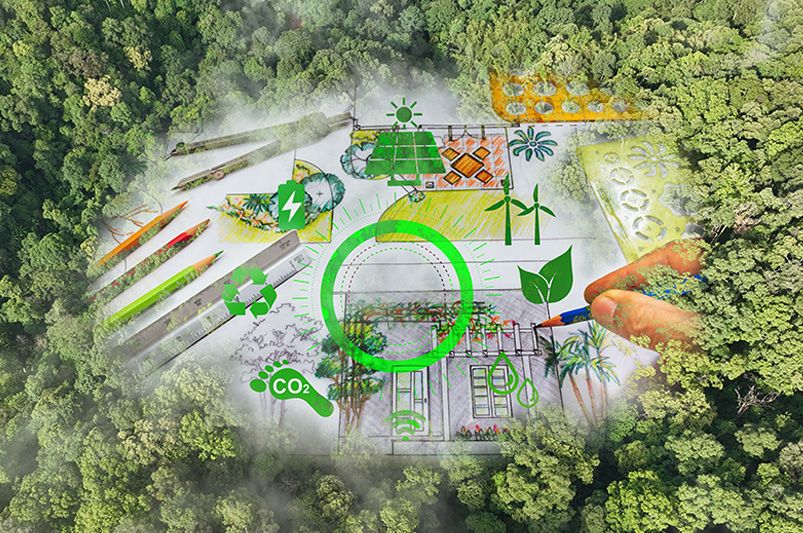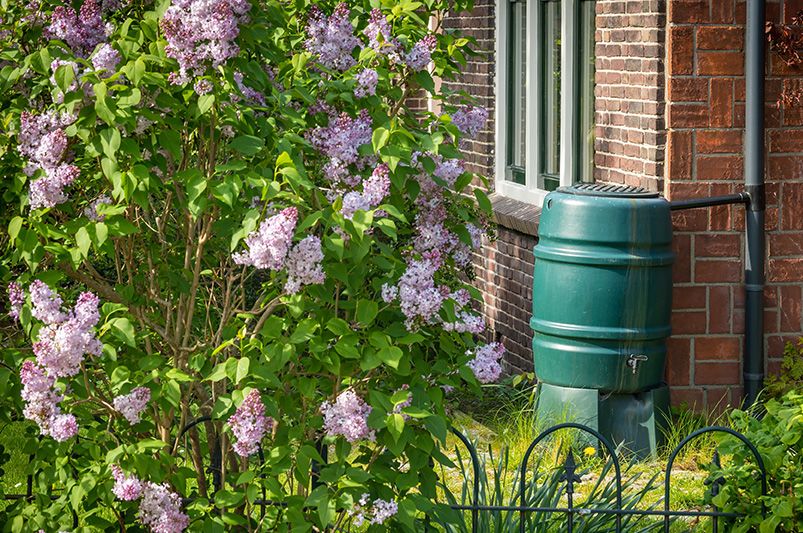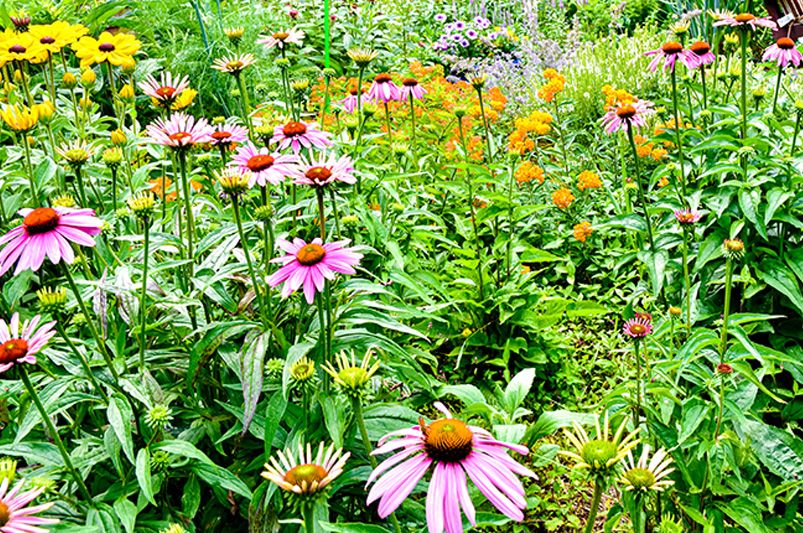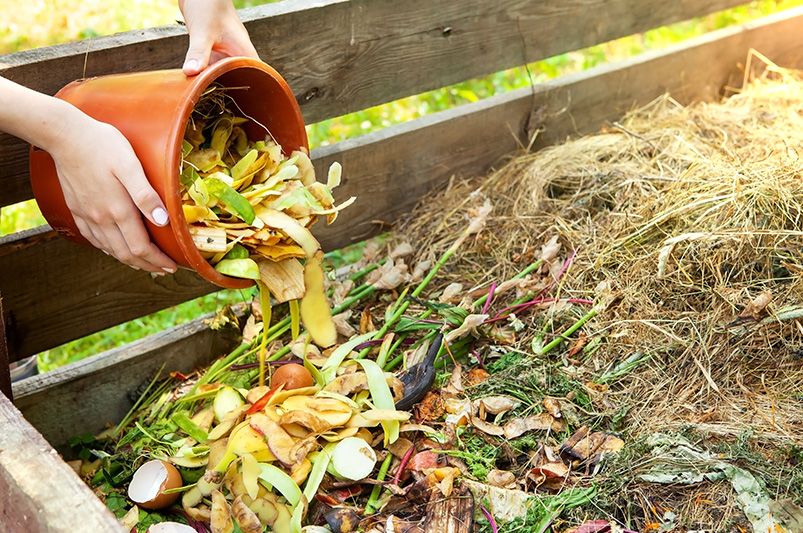
Sustainable Gardening: 10 Eco Friendly Garden Design Ideas
Published: 22/08/2024 | Updated: 22/08/2024
Key Highlights
- Discover eco-friendly garden design ideas for a sustainable outdoor space.
- Learn about native plants, water conservation techniques, and organic practices.
- Promote biodiversity with pollinator-friendly plantings and wildlife habitats.
- Explore sustainable materials and structures for a reduced environmental impact.
- Minimize waste and embrace composting for a closed-loop gardening system.
Introduction
In today’s world, people care more about the environment. This has made sustainable gardening very important. It is not only about making areas look nice. It is also about fighting climate change, saving resources, and living better with nature. By using sustainable gardening techniques, we can turn our gardens into places that support biodiversity. At the same time, we can lower our environmental footprint.


Exploring 10 Eco-Friendly Garden Design Ideas
Creating a friendly garden is a great way to enjoy nature and help the environment. Sustainable gardening practices can be simple or more complex. These changes can make your garden better for the ecosystem. By following these ideas, you can make a garden that looks nice and is good for the planet.
You can start by using native plants that grow well in your area. Water-saving methods and organic practices are also good options. There are many ways to design a sustainable garden. Here are ten friendly garden ideas that will inspire you to make a greener outdoor space.
1. Incorporate Native Plants for Sustainability
One of the best ways to build a sustainable garden is to use native plants. Native plants grow well in your local climate and soil. They need less water, fertilizer, and care. These plants also attract local wildlife, such as beneficial insects and pollinators. This helps to increase biodiversity in your garden.
When you choose native plants, you create a garden that is easier to maintain and uses less water. You also help keep the ecological balance in your area. Native plants are strong and beautiful, making them an important part of a friendly garden design.
There are many native plant options, from colorful wildflowers to large trees. These plants can change your garden into a lively habitat while reducing your impact on the environment. Check out the native plant species near you and add them to your garden design. This will give you a truly sustainable and biodiverse outdoor space.
2. Utilize Drought-Tolerant Landscaping Techniques
Water conservation is important for sustainable gardening, especially in areas with little rain. Choose plants that can survive with less water. This helps to lower the need for irrigation. Think about xeriscaping, which uses special plants, groups them by water needs, and uses mulch to keep soil moist.
You can also set up efficient irrigation systems like drip irrigation. This type delivers water right to the plant roots, cutting down on waste and evaporation. By using these drought-friendly gardening methods, you can have a beautiful garden while saving water.
Another idea is to use rainwater harvesting systems, such as rain barrels or water butts. These collect rainwater to use for watering your plants. This gives you a steady water source while letting you use less municipal water.

3. Implement Rainwater Harvesting Systems
Implementing rainwater harvesting systems is a smart and eco-friendly way to save water in your garden. By collecting rainwater from rooftops, you can depend less on city water. This water is often better for your plants because it is natural. Rain barrels and water butts are good choices for collecting and storing this rainwater.
Rain barrels connect to downspouts. They catch the rainwater and stop it from going into storm drains. You can use this water for many gardening tasks, like watering your plants, cleaning your tools, or filling decorative ponds. Setting up a rain barrel is easy. It’s a simple step that helps with sustainable gardening.
Water butts also collect and hold rainwater. When deciding between a rain barrel or a water butt, think about your garden's size and the amount of rain you get in your area.
4. Opt for Organic Mulches to Enrich Soil
Maintaining healthy soil is very important for a good garden. Organic mulches like wood chips, shredded bark, or compost have many benefits. They help keep the soil healthy and save water. Mulch works as a protective cover. It keeps the soil warm, stops weeds, and reduces evaporation.
When organic mulch breaks down, it adds needed organic matter to the soil. This improves the soil's structure, its nutrition, and how well it holds moisture. In contrast to synthetic mulches, organic ones help make a stronger soil ecosystem.
By putting a layer of organic mulch around your plants, you create a better place for them to grow. This will lessen the need for watering. It also helps keep your garden sustainable for a long time.
5. Design with Permeable Paving for Better Water Absorption
Traditional concrete and asphalt surfaces can cause water runoff and soil erosion. You might want to think about using permeable paving materials like gravel, porous pavers, or stepping stones. These materials let water soak into the ground. This helps replenish groundwater, cuts down on runoff, and stops soil from becoming compacted.
You can use permeable paving materials in pathways, patios, or driveways. They mix functionality with being good for the planet. They improve the look of your garden and help manage water better.
Also, paving surfaces that allow water to pass through can lead to a healthier environment. They reduce the urban heat island effect. This effect happens when hard surfaces absorb and release heat, raising temperatures in cities.

6. Establish a Pollinator-Friendly Garden with Diverse Plantings
Pollinators like bees, butterflies, and hummingbirds are very important for our environment. Sadly, their numbers are going down because they are losing their homes and pesticides are being used. Making a friendly garden can help these useful creatures by giving them a safe place and food to eat.
Pick different types of flowering plants that bloom at various times through the year. This way, there is always nectar available. Use colorful plants with different flower shapes and sizes to attract more pollinators.
Try not to use pesticides, as they can harm pollinators. Instead, use natural ways to control pests or choose organic pest control options that are safe for these beneficial insects.
7. Integrate Vegetable Patches into the Landscape
Growing your own food is a great and sustainable practice. Add vegetable patches or raised beds to your garden design. This helps you enjoy fresh, homegrown produce and is good for reducing your carbon footprint. When you grow your own vegetables, you can control the use of pesticides. This means your food can be healthier for you and better for the environment.
Think about using companion planting techniques. This can help keep pests away and support the growth of your vegetables. For example, planting basil by tomatoes keeps tomato hornworms away. Marigolds can help deter aphids and nematodes.
When you grow your own food, you can also pick heirloom varieties. This helps preserve plant biodiversity and allows you to enjoy unique flavors that are often lost in mass production.
8. Use Solar Lighting for Energy Efficiency
Reduce how much you depend on traditional electricity by using solar-powered lights in your garden. Solar lights take in sunlight during the day and change it into electricity. This powers your outdoor space at night. These lights save energy, protect the environment, and can save you money over time.
Solar lights come in many styles and designs to fit any garden. You can find pathway lights, string lights, and spotlights for all your needs. Place these lights where they can highlight key areas, light up walkways, or create a cozy mood for evening events.
By choosing solar lighting, you enjoy a nicely lit garden. You also help reduce your carbon footprint and support sustainable energy practices.
9. Choose Eco-Friendly Materials for Garden Structures
When choosing materials for garden structures like fences, trellises, or raised beds, pick eco-friendly options that harm the environment less. Use reclaimed or recycled materials, such as reclaimed wood, recycled plastic lumber, or bamboo.
These materials are strong and look good while using fewer new resources. For example, reclaimed wood brings a rustic feel to gardens and helps reduce tree cutting. Recycled plastic lumber is easy to care for and stands up to weather, keeping plastic out of landfills.
Bamboo grows quickly and is a renewable resource. It is strong and sustainable, making it a great choice for different garden structures.

10. Create Compost Areas to Reduce Waste
Composting is a great way to cut down on waste at home. It helps you make fertilizer rich in nutrients for your garden. You should set up a space in your garden to collect kitchen scraps, yard waste, and other organic materials. Composting takes these items and turns them into useful soil that improves your garden.
Pick a composting method that fits your needs and space. You might choose a compost pile, a compost tumbler, or a worm composting bin. Each choice has its benefits and things to think about.
Composting lowers the amount of organic waste that goes to landfills. This waste creates methane gas, which is a strong greenhouse gas. When you compost at home, you help the environment and close the loop in your garden by recycling nutrients.
Conclusion
In conclusion, using eco-friendly garden design ideas can make your outdoor space look beautiful. It also helps the environment. You can use native plants, rainwater systems, and organic mulches to create a garden that cares for nature. These practices help you lower your carbon footprint and support local ecosystems. They also promote biodiversity. By choosing eco-friendly garden design, you take a step toward a greener future for yourself and the Earth. Start using these ideas today. Transform your garden into a sustainable oasis.
Frequently Asked Questions
How do native plants contribute to an eco-friendly garden?
Native plants are very important for a healthy ecosystem. They offer homes and food for local wildlife. These plants help support biodiversity. They also attract pollinators. Native plants need less care, which makes them key for a friendly garden design.
What are the benefits of using organic mulches?
Organic mulches are good for soil health. They add organic matter and help keep the soil moist. As they break down, they slowly release nutrients like nitrogen. This is important for anyone who wants to succeed in organic gardening.
Can eco-friendly gardens attract more wildlife?
Eco-friendly gardens bring in more wildlife. Using native plants helps create a friendly space for them. Adding water sources is also key. It’s best to avoid pesticides. These steps support biodiversity and attract beneficial insects and local wildlife.
What are some water conservation techniques for eco-friendly gardening?
Effective water conservation techniques are simple to follow. You can use plants that don't need a lot of water. Installing a rain barrel can help you collect rainwater. It is also important to improve your irrigation methods to waste less water. Lastly, applying mulch can help stop evaporation.
At ShrubHub, we know how rewarding it is to craft a beautiful eco friendly outdoor space for your home. That’s why we’re dedicated to guiding you through every step of the process, from choosing the finest elements to offering expert advice on care and maintenance. Ready to embark on your yard transformation journey? With ShrubHub, designing and implementing your dream landscape has never been simpler. Reach out to our 24/7 customer service team for assistance and let us help you create the perfect outdoor retreat!


